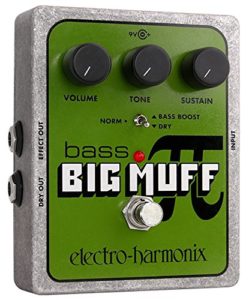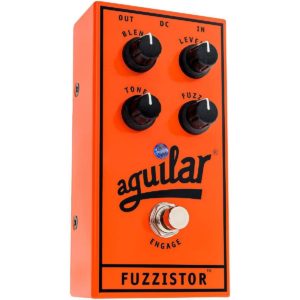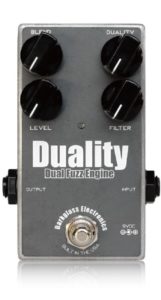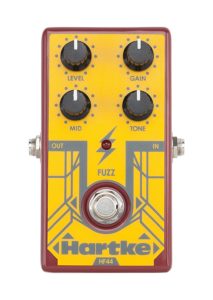Finding the best bass fuzz pedal is different from choosing a unit to produce the distortion and fuzz for the guitar. After all, you’re not seeking to reproduce six-string guitar sounds that will attract the attention of classic-rock fans.
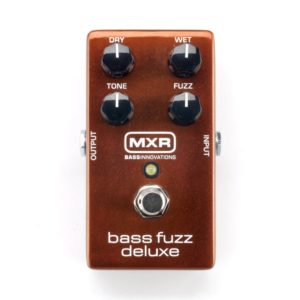
Using a fuzz pedal designed for the lead guitarist will not be satisfactory for the serious bass player who wants the right distortion level added to traditional punch and fullness.
Top 5 Best Bass Fuzz Pedals:
Electro-Harmonix Bass Big Muff Distortion Pedal (Editor’s Choice)
One of the real “veterans” of electronic products, Electro-Harmonix, has been around for half a century. Founder and CEO Mike Matthews has been deeply involved in music promotion and production since the company began in 1968.
The Bass Big Muff Distortion Pedal is a combination of two Muff classics from past years. The company defines this pedal as having “grit” and “grind” that owes its sound to the Big Muff Pi from Sovtek, and the Big Muff Pi made in New York. But his one is specifically for bass players. It offers the standard on/off switch and Volume, Tone, and Sustain dial controls.
A three-way switch gives Norm, Bass Boost, and Dry options. Power comes from one 9-volt battery, with an AC adapter sold separately. Low-end production is more than adequate, and the Big Muff has a direct out, so you can send it to a separate amplifier or an effects rig.
Pros
- Outstanding tone control for the money
- The bottom end is magnificent.
- Dry option
Cons
- Unreliable performance with select units
If you want a bass fuzz pedal that will rumble and last due to its solid construction, the Big Muff might be for you. Good performance for the price.
MXR M84 Bass Fuzz Deluxe Pedal
MXR has been producing dependable electronic products for quite some time. The M84 Bass Fuzz Deluxe Pedal is another solid unit in the Bass Innovations series. Designers have modified a vintage fuzz box to make it work for the 21st-century bassist. Plug it in and hear the bold, cutting sound without loss of low end and punch. Clarity, as you would expect, is excellent.
Controls include Tone and Fuzz, as well as Wet and Dry. These last two give the effect of hearing two different amplifiers, allowing you to blend to your taste. As with most top-end products, you get subtle sound on one end of the control range, but you can push it to the full fuzz on the other end. The circuitry designed into this pedal puts Fuzz and Tone control only on the Wet signal.
Pros
- Good bottom end hold
- Ease of dialing in different sounds
- Mixing Wet and Dry output
Cons
- I haven’t found one
The M84 has been around since 2011 and continues to deliver outstanding bass fuzz performance. Using the foundation of a vintage fuzz box, then modifying it for modern bass was a fantastic idea that works.
Aguilar Fuzzistor Bass Fuzz Pedal
When you put the Aguilar Fuzzistor Bass Fuzz Pedal between your bass and your amp, expect solid fuzz without loss of tone. As with other top pedals, this one gives you great control over the type of sound you want to produce. In addition to the stout on/off switch, this pedal has four controls – Blend, Tone, Level, and Fuzz.
The Blend knob lets you find the right mix of clean and fuzz, with separate fuzz delivery from that knob. The range should satisfy any player since it goes from subtle to “crushing.” Set your tone with what the company likes to call Tilt EQ. The pedal comes with a three-year warranty and a nine-volt battery operation. The power supply is optional.
Pros
- No bottom end loss
- Sensitive control to match sounds
- Aguilar reliability
Cons
- None other than optional power supply cost
The Fuzzistor from Aguilar holds the low end as well as any pedal designed for bass players. The range travels from warm and mild to all the snarl you could desire. The Blend control is a great feature that delivers reliable results. For a unit that’s versatile and conveniently usable, this is a good choice.
Darkglass Duality Fuzz Bass Fuzz Pedal
Beyond the perfect name for this fuzz pedal, you are also buying excellent control features. Set the level with the traditional volume control, then blend the clean and fuzz. The loudness of the processed sound is set by the Level knob, while the clean signal remains at unity gain.
This unit also has a filter control (low pass), letting you cut the high content or bring it up as needed. You get the perfect presence and edge with this control feature. The Darkglass Duality Fuzz Bass Pedal also has Duality control for selecting and mixing the fuzz circuits.
Moving this now counter-clockwise (to the left) gives you a traditional saw-tooth shape. When it’s turned fully to the right (clockwise), the result is modern and high-gain.
Pros
- Filter and Duality controls
- Old School and New School sounds
- Dirty fuzz without a break-up
Cons
- If there is a con to the Darkglass fuzz pedal, it’s the extra money you have to pay for the power supply. No battery operation.
Available since 2013, the Duality Fuzz Bass pedal will deliver player control to color and fill out your tone. Versatility might be the best word to describe a high-quality product for “choosy” bass players.
Hartke HF44 Bass Fuzz Effects Pedal
When you choose the Hartke HF44 Bass Fuzz Effects Pedal, you get a rugged unit that’s compact and easy to control. Knob controls include Level, Gain, Tone, and Mid, the last two delivering excellent harmonic character and the edge you want at higher frequencies.
The punch you want comes from all-analog circuitry, which you may be used to hearing from classic “stomp box” units. You’ll like the body of sound, along with the tone that approaches output from a tube amplifier. This company has produced performance systems for almost 40 years, including amplifiers, cabinets, and combos.
Pros
- Quiet operation, clarity
- Performance for price
- Hartke experience with electronics
Cons
- Range not as dramatic as desired
Buyer’s Guide: How to Choose the Best Bass Fuzz Pedal
Bass Ain’t guitar
When you start your search for a fuzz pedal for bass, begin with the end in mind. That means knowing how you will be using the unit within your band’s overall sound, as well as how it will enhance your traditional bass-playing skills.
A few low-end veterans have never used distortion or fuzz simply because they didn’t like the sound produced by units meant for the guitar. Their view of this additional sound might be different if they had access to some of the newest products, which allow the bassist to maintain edge and power. A bassist does not have to “disappear” within the band sound in an attempt to get some fuzz.
One idea is essential to getting good bass-fuzz sound: You can’t approach your shopping/search with the idea that both guitar fuzz and bass fuzz distort sound, so they must be the same. As one wise fellow said, “It just ain’t so.” You can put your bass signal through a guitar fuzz, but there will usually be noticeable tone differences when you compare them to an effects pedal designed for the bass range.
Tightening the Sound?
Ask yourself this question when you start searching for the best bass fuzz pedals. When a guitarist uses distortion or fuzz, the goal is usually a tight sound or tightening of an already good sound. This is because the lead guitar units tend to filter out low frequencies, which is what a bass player wants to preserve, right?
Traditional guitar fuzz pedals usually leave the bass sound thin. Higher notes will buzz, especially with the “G” on a four-string or the higher strings on six-string bass, but that’s not what most players are searching for. You can buy a fuzz pedal meant to be used with a tuned-down or “detuned” guitar. It seems they work rather well for many bassists. Try a combination pedal that gives you control of distortion and a cleaner sound.
What Should You Look For?
To bring this brief look to a summarized state, you should consider some of the features you’ll be looking for before getting into individual units. With that information, you can decide if those features will deliver the benefit that is the object of your search.
What is the essential item when buying any music equipment? The answer can be summed up in one word: control. The designers and manufacturers focus on control as you shop for a suitable bass-fuzz unit and look for evidence. Search for words such as “level,” “blend,” and “filter.” If you see phrases like “complete control” and “deep tone,” you’re on the right track.
In addition to control, you should also be on the lookout for ease of use and reliable construction. When you get ready to play a specific song, you’ll try a few settings and leave them in that position as you start. However, if you want to make changes or turn the unit off and on, you should do so without wasting a lot of time. Controls should be easy to use. It’s that simple.
Solid construction shouldn’t be a problem if you spend the money to purchase a quality unit. But, then, follow the recommendations of fellow bass players. They’ll guide you to the right choice almost every time.
Product Reviews
Getting a good overview of the best bass fuzz pedals is helpful, of course, but if you’re going to spend some hard-earned money on the suitable unit, you’ll need to get much closer to each product. As with any electronic equipment used for producing music, you’ll need to balance cost with results as you shop for a fuzz pedal. Prices can vary widely, so use both budget and the unit’s sound as your guides.
The Best Bass Fuzz Pedal: Our Choice
When you’re looking for a bass fuzz pedal to give you a tone range and some dirt without losing the solid foundation every bass player desires, you have several outstanding options. Prices vary widely, yet each of the reviewed products will perform. It’s difficult to find problems or “cons” with any of the units reviewed.
You may want to start with a brand you’re familiar with if you’ve had a positive experience with them in the past. But then, there’s something to be said for trying a different company, especially within this group. You probably won’t be disappointed. Bass players with plenty of experience will probably find any of these (or all of these) will deliver the necessary sound control.
As mentioned initially, choosing from the Darkglass, Aguilar, MXR, Electro-Harmonix, and Hartke bass fuzz pedals comes down to balancing performance with price. Ask yourself what sound you’re looking for and what price you’re willing to pay for that result.
If we still had to pick the best bass fuzz pedal, it would probably be the MXR M84. This pedal can deliver outstanding bass fuzz performance for a pretty affordable price.
